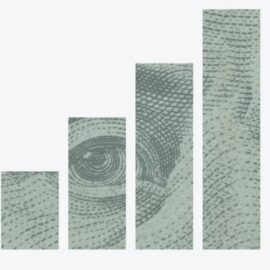

This article is an excerpt from the Shortform book guide to "I Will Teach You to Be Rich" by Ramit Sethi. Shortform has the world's best summaries and analyses of books you should be reading.
Like this article? Sign up for a free trial here .
Are you looking for a complete beginner-friendly introduction to investing? Why do money gurus recommend starting to invest while young—ideally, in your twenties?
Investing is the best way to grow your money into more money, and starting early is crucial to maximizing that growth. However, so many young people miss out on lucrative returns by not investing.
In this article, we’ll go through the basics of investing: the benefits of starting young, the types of asset classes you could invest into, and the difference between investing into actively managed mutual funds and passively managed index funds.
The Power of Compounding
Investing is the most powerful way to grow your money because it offers a higher rate of return than even the best savings accounts. On average, the stock market’s annual net return is about 8% (after accounting for inflation). That number is an average from decades worth of data, which means that your money will earn an average of 8% per year over the long-term, even if that rate fluctuates in the short-term.
The reason why that 8% rate is so important is the power of compound interest. With compounding, the interest you earn in a given year is added to the principal (original) amount you invested; then, the following year, you earn interest on that new principal amount.
- For example, let’s say you invest $100 in the stock market (to make things easy, we’ll assume an exact 8% annual rate of return). That means that after one year, you’d have earned $8, for a new total of $108. In the second year, you then earn an 8% return on that new amount, so you’d earn $8.64 for a new total of $116.64. The longer you leave your money in the stock market, the more that principal grows, and the more you earn every year.
Compounding maximizes returns on a one-time investment—but if you keep investing more money at regular intervals, those returns grow exponentially. The more you add, the more your principal grows, which creates a higher total for you to earn an 8% return on. In the table below, you can see the difference after 10 years of investing $10 per week compared to investing $50 per week.
| Amount invested per week | Total after 1 year | Total after 5 years | Total after 10 years |
| $10 | $541 | $3,173 | $7,836 |
| $20 | $1,082 | $6,347 | $15,672 |
| $50 | $2,705 | $15,867 | $39,181 |
The Importance of Starting Young
The power of compounding also means that the longer you leave your money in the market, the more it grows—which means that the earlier you start investing, the more money you’ll have by the time you retire. To see this in action, consider two fictional people who both decide to invest $200 every month.
- Sally starts investing at age 35 and keeps actively contributing to her accounts for 10 years (after that, she lets her money grow without actively adding more to it). By the time she’s 65, her accounts will be worth $181,469 (assuming an 8% rate of return).
- Dan, on the other hand, doesn’t start investing until he’s 45, but he keeps it up for 20 years. By the time he’s 65, Dan’s accounts will be worth $118,589—that’s $60,000 less than Sally, even though Dan invested for twice as long!
(However, this doesn’t mean you shouldn’t start investing if you’re already in your 40s. Your money will still grow—maybe not as much as it would have if you’d started 10 years ago, but far more than it will if you never get started at all!)
Invisible Investment Scripts
As we’ve seen, if you start investing when you’re young, you’ll earn tens or even hundreds of thousands more over the course of your lifetime than someone who starts investing later. So why aren’t more young people investing? The answer has to do with the invisible scripts we all have about investing:
- “There’s too much information. I’m overwhelmed.” Remember that you don’t have to be perfect, you just have to get started. Pick one source of information to start with and go from there.
- “I don’t know how to time the market.” You don’t have to. Just invest a little bit every week, regardless of what the market’s doing, and you’ll come out on top in the long run.
- “Investing in stocks means giving up control of my money.” It might seem counterintuitive, but this is a good thing. Studies show that consistent, automated investing leads to greater returns than if you try to buy, sell, and trade on your own.
- “I don’t know enough to do it right, so I’m better off doing nothing.” Not only are you losing out on the opportunity to grow your money, but doing nothing will actually lose you money in the long run because of inflation.
- “The fees are too high.” The fees are only high if you’re actively trading stocks, which you won’t be if you follow Sethi’s advice to automate your investments.
- “I don’t make enough money.” It’s hard to think about investing when you’re living paycheck to paycheck, but if you sit down and look at your spending habits, you’ll more than likely find a place where you can cut $10 per week to invest instead.
All of these invisible scripts about investing usually have the same outcome: People put off thinking seriously about their finances until their 40s, when they suddenly realize they might not have enough money for retirement. Starting earlier—even if you’re not an expert—will save you years of worry down the line.
Understanding Asset Classes
Start your investing journey by learning more about different asset classes, which are the building blocks of investing.
Asset classes are simply types of investments (like stocks or bonds), and each asset class has varied assets within it. For example, “stocks” is an asset class composed of all kinds of different stocks: large companies, small companies, international companies, and so on. Let’s look at each asset class in more detail, starting with stocks.
Stocks
When you think of investing, you probably think of stocks first. Stocks are shares of ownership in a particular company. Stocks are one of the most unpredictable investments because their value is determined by the shareholders. For example, if a company seems to be doing really well, more and more people will want to buy stock in that company, which drives up the price of each individual share. But if something happens to shake people’s faith in that company (like a merger or a supply shortage), shareholders will start selling off their shares and cause the stock price to drop.
Bonds
Bonds are a different type of asset class. They’re a much more stable investment than stocks because the value of a bond doesn’t fluctuate based on the whims of the market. When you buy a bond, you’re essentially giving a small loan to the bond issuer (which can be the federal government, local governments, or a corporation) with a predetermined payback period. Bonds provide a buffer against market volatility, which means that if some of your investments are in bonds rather than stocks, you won’t lose your entire investment if the market crashes.
Understanding Mutual vs Index Funds
The second important concept you must know about is the difference between mutual and index funds. Both index funds and mutual funds allow you to invest in a diverse group of investments. The main difference is that index funds invest in a specific group of assets (e.g. S&P 500 stocks), while mutual funds invest a changing list of assets, selected by a fund manager.
Active Management: Mutual Funds
A mutual fund is a collection of different investments. Mutual fund managers buy each of those specific investments (using a pool of money contributed by a group of individual investors) depending on what they think will generate the best returns. We call this “active management” because an actual human is in charge of picking and choosing where to invest the fund’s money.
The benefit of a mutual fund is that each person who buys into it is automatically investing a little bit of money in each of the stocks and bonds that make up the fund. In other words, as an investor, you get all the benefits of a diverse investment portfolio without having to worry about picking specific stocks yourself. Mutual funds also sometimes produce amazing returns, but that performance only lasts a year or two.
However, actively managed mutual funds have a major downside: fees. We already know that mutual fund managers typically can’t beat the average market returns—so if you invest in a mutual fund, not only will you likely see subpar returns, but you’ll pay significant fees that sap the value of your investment even further. These fees (or “expense ratios”) are usually 1-2% of assets managed per year. That may not sound like a lot, but those fees compound—which means a 1% fee can end up reducing your overall returns by a whopping 30% in the long run.
Passive Management: Index Funds
Thankfully, you can bypass those fees by investing in index funds. Index funds are “passively managed” because they don’t have a fund manager who chooses which stocks and bonds to invest in. Instead, they use a computer algorithm to automatically invest in all the stocks in a given index, which is a section of the stock market (for example, NASDAQ is an index of technology stocks). This means that the value of an index fund will rise and fall in the same pattern as the section of the market that the index represents.
In the short term, index funds might not always match the returns of mutual funds because they track so closely with the wider market. However, in the long run, passively managed funds are a far better deal because there is no fund manager’s salary to pay, so the fees are much lower. For example, an index fund might have an expense ratio of 0.14% compared to a mutual fund’s 2% expense ratio.To understand how important those low fees are, let’s look at an example. If you invest $100 per month in a mutual fund with a 1% expense ratio and keep that making that monthly investment for 25 years, you’ll pay almost $12,000 more in fees than if you’d invested that same money in an index fundwith a 0.14% expense ratio (assuming the standard 8% return). The more money you invest, the more money you lose to mutual fund fees. For example, if you initially invested $5,000 in that same mutual fund and contributed another $1,000 each month after that, after 25 years, you’d pay $126,418 more in fees than you would for an index fund.
For a more complete introduction to investing, check out our summary of I Will Teach You to Be Rich by personal finance educator Ramit Sethi, which is aimed at total beginners.

———End of Preview———
Like what you just read? Read the rest of the world's best book summary and analysis of Ramit Sethi's "I Will Teach You to Be Rich" at Shortform .
Here's what you'll find in our full I Will Teach You to Be Rich summary :
- The small steps you can take towards living a "rich life"
- How to choose the right bank account and manage your credit cards
- How to create a financial system that grows your money automatically






